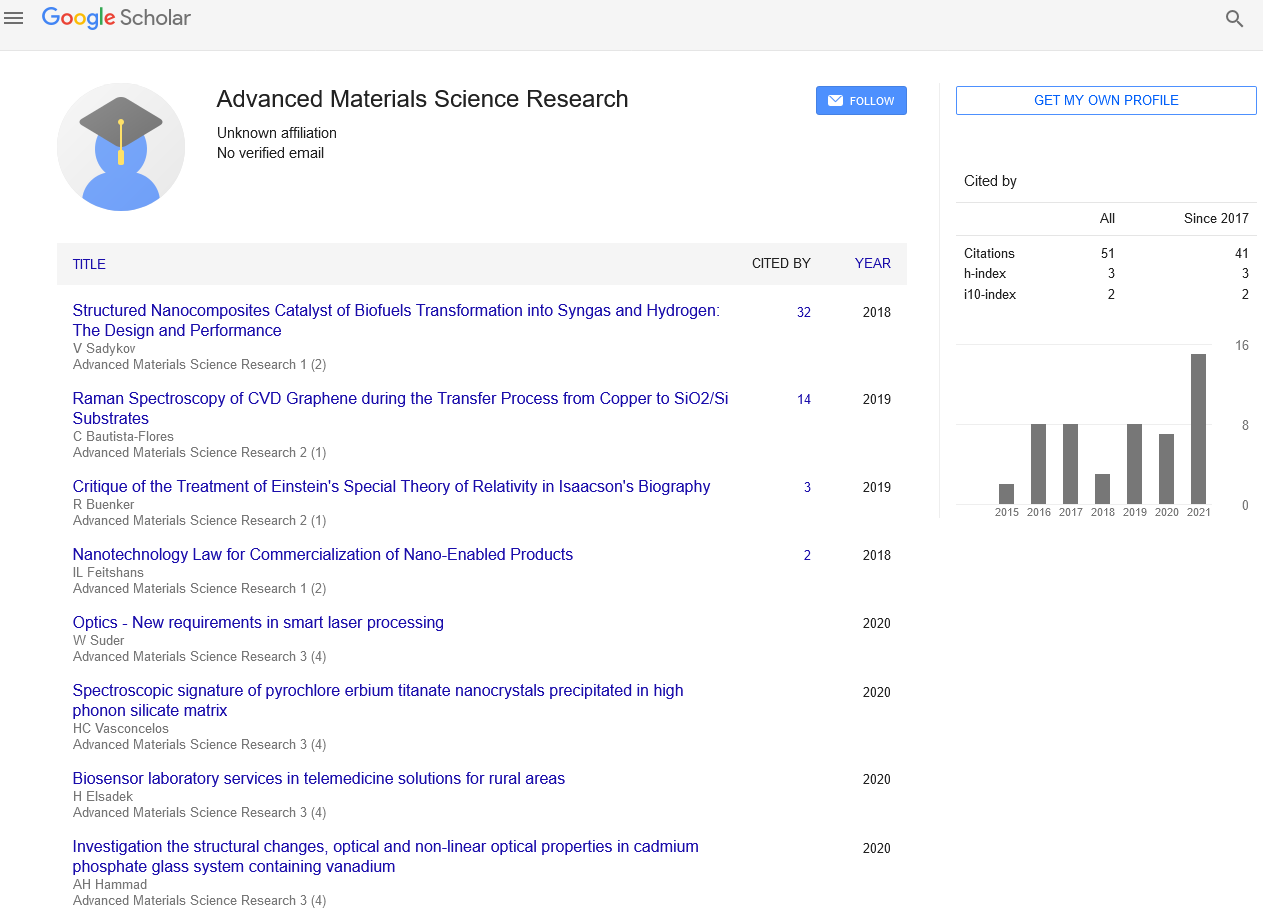Review Article - Advanced Materials Science Research (2023) Volume 6, Issue 1
Materials made of bioactive ceramics that have been designed to react with bone tissue
James Alexander*
Department of Material Science Somalia
Department of Material Science Somalia
E-mail: Alexander_j@gmail.com
Received: 30-Jan-2023, Manuscript No. aaamsr-23-87774; Editor assigned: 01-Feb-2023, Pre-QC No. aaamsr-23-87774 (PQ); Reviewed: 15- Feb-2023, QC No. aaamsr-23-87774; Revised: 18-Feb-2023, Manuscript No. aaamsr-23-87774 (R); Published: 25-Feb-2023; DOI: 10.37532/ aaasmr.2023.6(1).04-06
Abstract
However, not all clinical applications can be met by the bioactive ceramics that are currently available. As a result, it is necessary to create novel bioactive material designs. Osteoconduction is demonstrated by bioactive ceramics through the chemical reaction of the ceramic surface with body fluid. This results in the formation of biologically active, bone-like apatite. As a result, developing novel bioactive and biodegradable materials necessitates controlling their chemical reactivity in bodily fluids. New bioactive materials based on chemical reactivity in bodily fluids are examined in this paper
Keywords
Ceramics • Bioactivity • Hydroxyapatite • Calcium Phosphate • Hybrid • Coating
Introduction
When an area of damaged bone is too large for self-repair, the damaged bones must be repaired with alternative materials like autographs, allografts, and artificial materials. The methods used to repair damaged bones are also important. The high performance of autographs, which are transferred from healthy parts of the same patient’s bones, has led to their widespread use [1]. However, due to the fact that the patient’s bone tissue is removed, additional harm is done to the body and there are issues with the limited supply of tissue. Even though allografts, which are transplants from other people, are also used, they have issues with foreign body reactions and infections as well as a limited availability. In order to fix bone defects, artificial materials that are safe and free of these limitations are required. However, artificial materials that are inserted into bony defects are typically encased by fibrous tissue and do not adhere to living bone. Bioactive ceramics have received a lot of attention as a potential solution to the issue of the foreign body reaction, and some bioactive ceramics are currently being utilized clinically as bone substitutes [2]. Ceramics that are made with the intention of eliciting a particular biological activity for the purpose of repairing damaged organs are known as bioactive ceramics. The ability to make direct contact with living bone after implantation in bony defects is regarded as bioactivity for the purpose of repairing bone tissues. Osteoconductivity is the phenomenon of new bone formation on bioactive ceramic surfaces [3]. Due to their bioactivity, which enables them to achieve tight fixation through direct bonding to living bone, some bioactive ceramics have already been used to repair defects in bone. In the Na2O–CaO–SiO2–P2O5 system that followed, a glass was the first bioactive ceramic developed. Bioglass is the name of this bioactive glass. Numerous researchers have created a variety of bioactive ceramics, including sintered hydroxyapatite, since the discovery of Bioglass [4]. However, the applications of these bioactive ceramics are limited to the replacement of bony parts under low loads and as bone fillers due to their lower fracture toughness and higher Young’s modulus than human cortical bone. Therefore, it is necessary to develop novel bioactive materials with a high affinity for bone tissue in addition to a variety of mechanical and biological properties. After being implanted in bony defects, bioactive ceramics produce a layer of biologically active bone-like apatite on their surfaces, according to previous research [5]. Therefore, in order to demonstrate the property of direct bonding to living bone, ceramic materials must first form a bone-like apatite layer on their surfaces after being exposed to the body’s environment. Kokubo and his colleagues proposed that bioactive ceramics can be immersed in a simulated body fluid (SBF) and develop a similar bone-like apatite layer [6].
Glass-Ceramics with bioactivity
The glass composition for a bioactive glassceramic is depicted in a design. Bioglass exhibits high bone-bonding ability and high reactivity in the body’s environment, or bioactivity. The high potential for the materials to react with bodily fluid to form bone-like apatite is the cause of this high bioactivity. The following chemical equilibrium exists in body fluid, which is an aqueous solution that is supersaturated with respect to hydroxyapatite [7]. The incorporation of additional ions, such as Mg2+, HPO4 or CO32 ions, during apatite formation from body fluid is not taken into account by this equation, which is somewhat simplified. Due to the low mechanical strength of the silica gel layer, which reduces bonding between the glass and the bone, the formation of this thick silica gel layer is undesirable. As a result, the design needs to be one in which the glass does not form a thick layer of silica gel. CaO–SiO2–P2O5 glasses in the CaO–SiO2 binary system have been identified as the fundamental components for producing bioactive glasses, according to a report that evaluates the capability of bonelike apatite formation on glasses in the ternary system. These glasses were exposed to SBF glasses [8]. A bioactive glass of this kind typically has a composition of 50CaO50SiO2 mol%. After soaking in SBF, however, a thick silica gel layer is observed between the apatite layer and the glass due to the glass’s high reactivity in the body environment. Based on a fundamental study of apatite formation in the ternary MgO–CaO– SiO2 system, MgO was added to CaO–SiO2- based glass ceramics to reduce the silica gel layer. Magnesium has already been utilized in bioactive glass-ceramics, such as glass-ceramic A–W, which does not produce such a thick silica gel layer in the body environment. Magnesium is one of the major inorganic elements in body fluids. The thickness of the silica gel layer between the apatite layer and the glass decreased when MgO was used to partially replace CaO. Within three days, apatite was formed in SBF by a glass with a composition of 10MgO-40CaO- 50SiO2 mol%. The apatite layer appeared to be in direct contact with the glass substrate without the formation of a thick silica gel layer [9]. As a result, it is anticipated that the apatite and the glass substrate will bond strongly. As a result, it is anticipated that the composition of 10MgO- 40CaO-50SiO2 mol% will be useful for creating bioactive glass ceramics. Utilizing this concept.
Bio activated hybrids
However, when designing a material that will be implanted for an extended period of time, it is essential to adjust the mechanical properties of bone. Because the mechanical properties of ceramic materials differ from those of natural bone, bioactive ceramics do not suit all clinical applications despite their specific biological activity with bone tissue. It is desired to develop bioactive materials with mechanical properties comparable to those of living bone as well as bioactivity [10]. A combination of 70% apatite and 30% collagen makes up living bone. As a result, a novel bone-repairing material with mechanical properties comparable to living bone could be created by combining an organic substance with bioactive inorganic components. In the body’s environment, the CaO–SiO2 binary system can provide the fundamental composition necessary to form a bone-like apatite layer, as previously mentioned[11]. The mechanism for triggering the formation of bone-like apatite layers in SBF groups on the surface of the materials is important to induce heterogeneous nucleation of apatite and the release of Ca2+ from the materials, as suggested by the in-depth investigation of the formation of bone-like apatite layers on a glass with a composition of 50CaO50SiO2 mol%. The idea that organic modification of chemical species that enables the formation of Si–OH groups and the release of Ca2+ after exposure to body environments can be used to produce bioactive organic–inorganic hybrids is introduced by this finding. Sol–gel processing, which can be carried out at a low temperature and is a popular method for preparing hybrids of inorganic and organic components, was used to attempt the development of several different kinds of organic–inorganic hybrids. Polydimethylsiloxane poly (tetra methylene oxide) (PTMO)–CaO– SiO2, among others, are bioactive hybrids capable of forming bone-like apatite. These were found to exhibit SBF-specific apatite-forming capability. The bioactive inorganic component of these hybrids chemically bonds to the organic component and is uniformly distributed at the molecular level.
References
- Chang BS, Lee CK, Hong KS et al. Osteoconduction at porous hydroxyapatite with various pore configurations. Biomaterials. 21, 1291–1298 (2000).
- Famery R, Richard N, Boch P. Preparation of α- and β-tricalcium phosphate ceramics, with and without magnesium addition. Ceram Int. 20, 327–336 (1994).
- Hench LL, Splinter RJ, Allen WC et al. Bonding mechanism at interface of ceramic prosthetic materials J Biomed . Mater Res Symp. 2, 117–141 (1971).
- Jarcho M, Kay JL, Gumaer RH et al. Tissue, cellular, and subcellular events at a bone–ceramic apatite interface. J Bioeng. 1, 79–92 (1977).
- Kawashita M, Nakao M, Minoda M et al. Apatite-forming ability of carboxyl group-containing polymer gels in a simulated body fluid. Biomaterials. 24, 2477–2484 (2003).
- Li P, Ohtsuki C, Kokubo T et al. The role of hydrated silica, Titania and alumina in inducing apatite on implants. J Biomed Mater Res. 28, 7–15(1994).
- Oishi M, Ohtsuki C, Kitamura M et al. Fabrication and chemical durability of porous bodies consisting of biphasic tricalcium phosphates. Phosphorus Res Bull. 17, 95–100 (2004).
- Rejda BV, Peelen JG, Groot K. Tricalcium phosphate as a bone substitute. J Bioeng. 1, 93–97 (1977).
- Saito A, Suzuki Y, Ogata S et al. Activation of osteo-progenitor cells by a novel synthetic peptide derived from the bone morphogenetic protein-2 knuckle epitope. Biochimi Biophys Acta. 1651, 60–67 (2003).
- Takeuchi A, Ohtsuki C, Kamitakahara M et al. Biodegradation of porous alpha-tricalcium phosphate coated with silk sericin. Key Eng Mater. 286:329–332 (2005).
- Uchida M, Kim HM, Miyaji F et al. Bonelike apatite formation induced on zirconia gel in a simulated body fluid and its modified solutions. J Am Ceram Soc. 84, 2041–2044 (2001).
Indexed at, Google Scholar, Crossref
Indexed at, Google Scholar, Crossref
Indexed at, Google Scholar, Crossref
Indexed at, Google Scholar, Crossref
Indexed at, Google Scholar, Crossref
Indexed at, Google Scholar, Crossref
Indexed at, Google Scholar, Crossref

